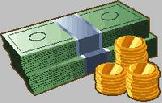
 |
|
| Financial Terms | |
| Traditional view (of dividend policy) |
|
Information about financial, finance, business, accounting, payroll, inventory, investment, money, inventory control, stock trading, financial advisor, tax advisor, credit.
Main Page: financial advisor, money, credit, business, stock trading, tax advisor, finance, accounting, |
Definition of Traditional view (of dividend policy)
Traditional view (of dividend policy)An argument that "within reason," investors prefer large dividends to
Related Terms:Agency cost viewThe argument that specifies that the various agency costs create a complex environment in Bankruptcy cost viewThe argument that expected indirect and direct bankruptcy costs offset the other Bankruptcy viewThe argument that expected bankruptcy costs preclude firms from being financed entirely Capital market imperfections viewThe view that issuing debt is generally valuable but that the firm's Cash dividendA dividend paid in cash to a company's shareholders. The amount is normally based on Collection policyProcedures followed by a firm in attempting to collect accounts receivables. Corporate tax viewThe argument that double (corporate and individual) taxation of equity returns makes  Cum dividendWith dividend. Cumulative dividend featureA requirement that any missed preferred or preference stock dividends be paid Discounted dividend model (DDM)A formula to estimate the intrinsic value of a firm by figuring the DividendA dividend is a portion of a company's profit paid to common and preferred shareholders. A stock Dividend clawbackWith respect to a project financing, an arrangement under which the sponsors of a project Dividend clienteleA group of shareholders who prefer that the firm follow a particular dividend policy. For Dividend discount model (DDM)A model for valuing the common stock of a company, based on the Dividend growth modelA model wherein dividends are assumed to be at a constant rate in perpetuity. Dividend limitationA bond covenant that restricts in some way the firm's ability to pay cash dividends.  Dividend payout ratioPercentage of earnings paid out as dividends. Dividends per shareAmount of cash paid to shareholders expressed as dollars per share. Dividend policyAn established guide for the firm to determine the amount of money it will pay as dividends. Dividend rateThe fixed or floating rate paid on preferred stock based on par value. Dividend reinvestment plan (DRP)Automatic reinvestment of shareholder dividends in more shares of a Dividend rightsA shareholders' rights to receive per-share dividends identical to those other shareholders receive. Dividend yield (Funds)Indicated yield represents return on a share of a mutual fund held over the past 12 Dividend yield (Stocks)Indicated yield represents annual dividends divided by current stock price. Dividends per sharedividends paid for the past 12 months divided by the number of common shares Extra or special dividendsA dividend that is paid in addition to a firm's "regular" quarterly dividend. Ex-dividendThis literally means "without dividend." The buyer of shares when they are quoted ex-dividend  Ex-dividend dateThe first day of trading when the seller, rather than the buyer, of a stock will be entitled to Fiscal policyThe use of government spending and taxing for the specific purpose of stabilizing the economy. Homemade dividendSale of some shares of stock to get cash that would be similar to receiving a cash dividend. Indicated dividendTotal amount of dividends that would be paid on a share of stock over the next 12 months Liquidating dividendPayment by a firm to its owners from capital rather than from earnings. Monetary policyActions taken by the Board of Governors of the Federal Reserve System to influence the Pecking-order view (of capital structure)The argument that external financing transaction costs, especially Perfect market view (of capital structure)Analysis of a firm's capital structure decision, which shows the Perfect market view (of dividend policy)Analysis of a decision on dividend policy, in a perfect capital Personal tax view (of capital structure)The argument that the difference in personal tax rates between Policy asset allocationA long-term asset allocation method, in which the investor seeks to assess an Progress reviewA periodic review of a capital investment project to evaluate its continued economic viability. Residual dividend approachAn approach that suggests that a firm pay dividends if and only if acceptable Signaling view (on dividend policy)The argument that dividend changes are important signals to investors Special dividendAlso referred to as an extra dividend. dividend that is unlikely to be repeated. Stock dividendPayment of a corporate dividend in the form of stock rather than cash. The stock dividend Taking a viewA London expression for forming an opinion as to where market prices are headed and acting on it. Tax differential view ( of dividend policy)The view that shareholders prefer capital gains over dividends, Variable life insurance policyA whole life insurance policy that provides a death benefit dependent on the With dividendPurchase of shares in which the buyer is entitled to the forthcoming dividend. Related: exdividend. DividendA payment a company makes to stockholders. Earnings before income tax. The profit a company made DividendThe payment of after-tax profits to shareholders as their share of the profits of the business for an accounting period. Dividend incomeIncome that a company receives in the form of dividends on stock in other companies that it holds. DividendsAmounts paid to the owners of a company that represent a share of the income of the company. dividend payout ratioComputed by dividing cash dividends for the year dividend yield ratioCash dividends paid by a business over the most dividend growth methoda method of computing the cost DividendA payment made to shareholders that is proportional to the number of shares cash dividendPayment of cash by the firm to its shareholders. collection policyProcedures to collect and monitor receivables. constant-growth dividend discount modelVersion of the dividend discount model in which dividends grow at a constant rate. credit policyStandards set to determine the amount and nature of credit to extend to customers. dividendPeriodic cash distribution from the firm to its shareholders. dividend discount modelComputation of today’s stock price which states that share value equals the present value of all expected future dividends. dividend payout ratioPercentage of earnings paid out as dividends. ex-dividend dateDate that determines whether a stockholder is entitled to a dividend payment; anyone holding stock before this date is entitled to a dividend. information content of dividendsdividend increases send good news about cash flow and earnings. dividend cuts send bad news. MM dividend-irrelevance propositionTheory that under ideal conditions, the value of the firm is unaffected by dividend policy. stock dividendDistribution of additional shares to a firm’s stockholders. Accomodating PolicyA monetary policy of matching wage and price increases with money supply increases so that the real money supply does not fall and push the economy into recession. Beggar-My-Neighbor PolicyA policy designed to increase an economy's prosperity at the expense of another country's prosperity. Cold-Turkey PolicyDecreasing inflation by immediately decreasing the money growth rate to a new, low rate. Contrast with gradualism. Demand Management PolicyFiscal or monetary policy designed to influence aggregate demand for goods and services. Discretionary PolicyA policy that is a conscious, considered response to each situation as it arises. Contrast with policy rule. DividendsProfits paid out to shareholders by a corporation. Fiscal PolicyA change in government spending or taxing, designed to influence economic activity. Incomes PolicyA policy designed to lower inflation without reducing aggregate demand. Wage/price controls are an example. Monetary PolicyActions taken by the central bank to change the supply of money and the interest rate and thereby affect economic activity. Policy-Ineffectiveness PropositionTheory that anticipated policy has no effect on output. Policy RuleA formula for determining policy. Contrast with discretionary policy. Tax-Related Incomes Policy (TIP)Tax incentives for labor and business to induce them to conform to wage/price guidelines. Analytical ReviewThe process of attempting to infer the presence of potential problems Policy Acquisition CostsCosts incurred by insurance companies in signing new policies, including expenditures on commissions and other selling expenses, promotion expenses, premium Preferred Stock Stock that has a claim on assets and dividends of a corporation that are priorto that of common stock. Preferred stock typically does not carry the right to vote. Delivery policyA company’s stated goal for how soon a customer order will be Material review boardA company committee typically comprising members representing Visual review systemInventory reordering based on a visual inspection of on-hand DividendAs the term dividend relates to a corporation's earnings, a dividend is an amount paid per share from a corporation's after tax profits. Depending on the type of share, it may or may not have the right to earn any dividends and corporations may reduce or even suspend dividend payments if they are not doing well. Some dividends are paid in the form of additional shares of the corporation. dividends paid by Canadian corporations qualify for the dividend tax credit and are taxed at lower rates than other income. Policy FeeThis is an administrative fee which is part of most life insurance policies. It ranges from about $40 to as much as $100 per year per policy. It is not a separate fee. It is incorporated in the regular monthly, quarterly, semi-annual or annual payment that you make for your policy. Knowing about this hidden fee is important because some insurance companies offer a policy fee discount on additional policies purchased under certain conditions. Sometimes they reduce the policy fee or waive it altogether on one or more additional policies purchased at the same time and billed to the same address. The rules are slightly different depending on the insurance company. There could be enormous savings if several people in the same family or business were intending to purchase coverage at the same time. PolicyholderThis is the person who owns a life insurance policy. This is usually the insured person, but it may also be a relative of the insured, a partnership or a corporation. There are instances in marriage breakup (or relationship breakup with dependent children) where appropriate life insurance on the support provider, owned and paid for by the ex-spouse receiving the support is an acceptable method of ensuring future security. Lending PolicyA course of action adopted by a financial institution to guide and usually determine present and future decisions in the light of given conditions. DividendUnlike dividends which are paid to company shareholders, participating insurance policy dividends are not based on the company's overall profits. Rather, they are determined by grouping policies by type and country of issue and looking at how each class contributes to the company's earnings and surplus. Dividend PolicyThis policy governs Canada Life's actions regarding distribution of dividends to policyholders. It's goal is to achieve a dividend distribution that is equitable and timely, and which gives full recognition of the need to ensure the ongoing solidity of the company. It also specifies that distribution to individual policyholders must be equitable between dividend classes and policyholder generations, and among policyholders within any class. Insurance Policy (Credit Insurance)A policy under which the insurance company promises to pay a benefit of the person who is insured. Joint Policy LifeOne insurance policy that covers two lives, and generally provides for payment at the time of the first insured's death. It could also be structured to pay on second death basis for estate planning purposes. Non-participating PolicyA type of insurance policy or annuity in which the owner does not receive dividends. Participating PolicyA policy offers the potential of sharing in the success of an insurance company through the receipt of dividends. PolicyA written document that serves as evidence of insurance coverage and contains pertinent information about the benefits, coverage and owner, as well as its associated directives and obligations. Policy AnniversaryYearly event linked to a policy. Usually the date issued. Policy DateDate on which the insurance company assumes responsibilities for the obligations outlined in a policy. Policy FeeAdministrative charge included in a policy Premium. Policy YearPeriod between two policy anniversaries. Related to : financial, finance, business, accounting, payroll, inventory, investment, money, inventory control, stock trading, financial advisor, tax advisor, credit. |